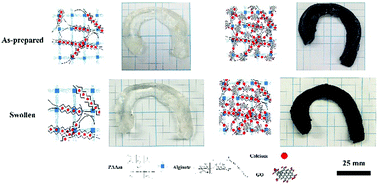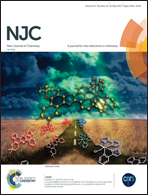Biocompatible swelling graphene oxide reinforced double network hydrogels with high toughness and stiffness†
Abstract
Tough swelling nanocomposite hydrogels have been fabricated via introducing graphene oxide (GO) and in situ synthesis. Upon addition of GO, the swelling properties of a calcium alginate/polyacrylamide (CA/PAAm) double network (DN) are considerably suppressed. Moreover, the mechanical properties of CA/PAAm DN gels and GO reinforced DN gels in swelling and as-prepared states have been systematically explored. The results affirm that the swelling largely damages the mechanical properties of gels, due to the osmotic pressure introducing solvents into the gaps between polymer chains and cross-linkers, thereby leading to weak spots in the gels. GO demonstrates the ability to improve the mechanical properties of pristine DN gels in both swelling and as-prepared states by offering large numbers of physical interpenetrations and chemical bindings between long polymeric chains and GO nanosheets, and building a Ca2+ coordination-induced GO network. The toughness of swelling nanocomposite gels is around 106 kJ m−3 that is comparable to that of cartilage in large animal joints. Furthermore, the consecutive loading–unloading tests and cytotoxicity tests show that the swelling nanocomposite gels, respectively, obtain superior fatigue resistance and high biocompatibility. Therefore, these swelling nanocomposite gels are promising as substitutes for load-bearing tissues.



 Please wait while we load your content...
Please wait while we load your content...